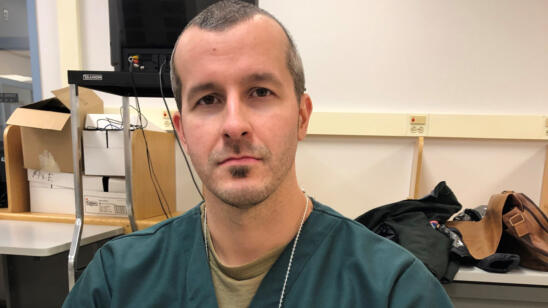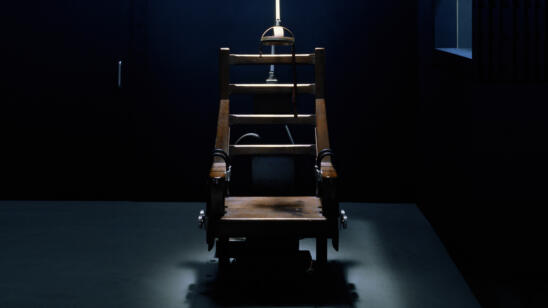On the day he was scheduled to be killed by lethal injection at Southern Ohio Correctional Facility in Lucasville, Ohio, Derrick Jamison received a visit to his cell.
“[There was] a doctor and a bunch of guards,” Jamison tells A&E True Crime. “The doctor checks your vitals, and the guards ask you what you want for your last meal. Then they ask you where they can send the body to.”
The doctor “was real professional about it,” Jamison says. “He was just doing his job.”
The guards were crying. “Some of them get to know you. And they like you,” he explains. “They knew me personally. They liked to keep me alive.”
Asked if he shed tears himself, Jamison pauses.
“I was just scared. I was in fear. I probably did—but I don’t remember.”
He doesn’t remember much of anything about that day. He doesn’t remember what last meal he ordered, or if he ate any of it when it arrived. He doesn’t remember where he was when the governor ordered a stay on his execution, 90 minutes before the scheduled fatal injection. He knows he never made it into the execution chamber. But most everything else, he says, he’s blocked out.
“You’ve got to,” Jamison explains. “Or it’ll destroy you.”
What he does remember is the general feeling of the day.
“You’re by yourself in your cell. Every minute feels like an hour. It was horrible—knowing you’re going to die. Waiting to die. My mama told me, ‘Whenever you’re feeling bad, pray.’ I did a lot of praying.”
Jamison had been sentenced to die in 1985 after being convicted of the murder of a bartender in Cincinnati. In the years that followed, new evidence came to light that suggested that the district attorney had illegally withheld evidence from the defense, and in 2005—after 20 years behind bars—he was exonerated and released from prison.
Jamison now works to educate people about the death penalty and wrongful convictions. In a 2015 interview with Salon, he said, “I’m not just an exoneree, I’m an abolitionist. I got friends who are still inside.”
How Are Prisoners Executed?
Because capital punishment is determined at the state level, execution-day protocol varies greatly in the country, says Robert Dunham, executive director of the Death Penalty Information Center.
“There isn’t such a thing as a [national] execution policy,” Dunham tells A&E True Crime. “Each state has its own protocol.”
One of the most contentious issues surrounding those disparate protocols is the means of execution. Of the 25 states that actively employ the death penalty, Dunham says that all states use lethal injection as their primary method—with some important discrepancies. Namely, not all lethal injections are the same.
The majority of death penalty states use a multiple-drug cocktail. In Ohio, where Jamison was scheduled for execution, the first drug administered is midazolam—a sedative that purportedly knocks the prisoner out.
“In some cases, you don’t stay out,” Dunham says. For that reason (and others), states have been moving away from midazolam-led three-drug executions.
The second drug of a three-drug cocktail is a paralytic agent, and the third is the killing drug—potassium chloride, usually—which is designed to stop the heart.
Some states, like Texas, eschew the three-drug cocktail, instead employing a single barbiturate, which pulls the inmate into sleep and halts breathing. In 2014, a bipartisan panel of legal experts urged three-drug states to follow Texas’s lead, saying that the single-drug execution is more humane. But many of those states have struggled to do so, in part because many pharmaceutical companies have refused, on ethical grounds, to provide barbiturates and other lethal drugs for use in executions.
As a result, many states have stuck with the three-drug execution. But due to the controversy around the suffering prisoners might feel with this method, some have requested they be killed in other ways.
In Tennessee, several inmates have successfully requested that they be killed instead by the electric chair.
“It wasn’t that they thought it wouldn’t be torturous,” says Dunham. ” They [just] thought it’d be torturous over a shorter period of time.”
In 2018, Alabama began letting death-row inmates opt out of the three-drug lethal injection for death by lethal doses of nitrogen gas. According to the Associated Press, 51 of Alabama’s 180 death-row inmates have chosen the gas. Oklahoma has likewise announced that they’ll begin using lethal gas.
In 2015, Utah passed a law allowing the state to put prisoners to death via firing squad, to be used only in the event that execution drugs are unavailable.
What Rights Do Prisoners Have on the Day of Their Executions?
“Traditionally, last meals are designed symbolically to recognize the humanity of the individual who is being executed, and to recognize the basic dignity of all people,” says Dunham.
These too can vary greatly from state to state.
“Some states set aside a fixed amount of money, and allow prisoners to order up to that level,” Dunham says. “Other states will provide a series of choices, and the prisoner gets to select from them.”
Texas banned last-meal requests in 2011, after a last-meal controversy involving the execution of Lawrence Brewer.
According to the Los Angeles Times, Brewer had ordered a final feast, which included “two chicken-fried steaks with gravy and sliced onions; a triple-patty bacon cheeseburger; a cheese omelet with ground beef, tomatoes, onions, bell peppers and jalapeños; a bowl of fried okra with ketchup; one pound of barbecued meat with half a loaf of white bread; three fajitas; a meat-lover’s pizza; one pint of Blue Bell Ice Cream; a slab of peanut-butter fudge with crushed peanuts; and three root beers.”
Brewer left his meal untouched, prompting Democratic state Senator John Whitmire to successfully push for the cessation of last-meal requests.
But meals aren’t the only ritual that prompt debate. There’s also the matter of spiritual guidance and religious comfort in the execution chamber itself.
Patrick Murphy, a Buddhist inmate, had his execution delayed by a Supreme Court decision when the state of Texas refused to provide a Buddhist spiritual adviser to accompany him into the chamber. Murphy had argued that the failure to accommodate the request was tantamount to religious discrimination, given that the state did provide Christian and Muslim chaplains for last rites in the execution chamber.
The justices agreed with the reasoning. In response, Texas banned chaplains of all faiths from entering the execution chamber, so that none of their condemned prisoners—Christian, Muslim, or otherwise—might unfairly receive the benefit of religious accommodation while others died without spiritual aid.
Related Features:
What’s It Like to Be a Prison Chaplain to Death-Row Inmates?
What Was Ted Bundy’s Execution Like?
What It Feels Like to Lose a Family Member on Death Row
Chris Watts, David Berkowitz and Other Infamous Killers Who Found God in Prison


